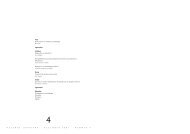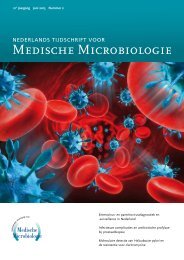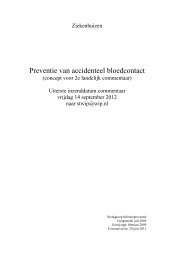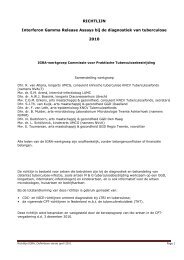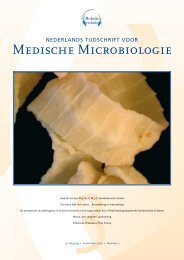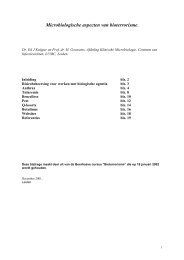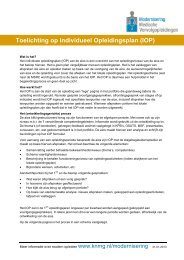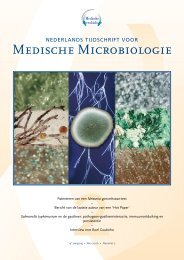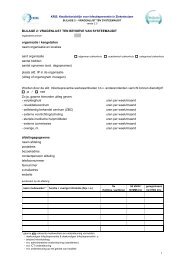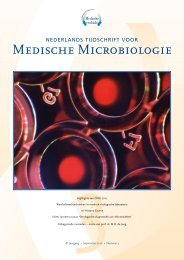Thema: Diabetes mellitus en infectieziekten Het ... - NVMM
Thema: Diabetes mellitus en infectieziekten Het ... - NVMM
Thema: Diabetes mellitus en infectieziekten Het ... - NVMM
- No tags were found...
Create successful ePaper yourself
Turn your PDF publications into a flip-book with our unique Google optimized e-Paper software.
Alle gramnegatieve stav<strong>en</strong> werd<strong>en</strong> gedetermineerd doorde Vitek 2 <strong>en</strong> ev<strong>en</strong>tueel geconfirmeerd door de Vitek MS(Biomérieux). Grampositieve stav<strong>en</strong> <strong>en</strong> kokk<strong>en</strong> werd<strong>en</strong>gedetermineerd middels gramkleuring, biochemischetest<strong>en</strong> of API 20 STREP (Biomérieux). Bij e<strong>en</strong> verd<strong>en</strong>kingop e<strong>en</strong> Vibrio cholera werd e<strong>en</strong> agglutinatietest verricht.Schimmels werd<strong>en</strong> gedetermineerd middels microscopie.Van de uit de watermonsters gekweekte bacteriën <strong>en</strong>schimmels kwam<strong>en</strong> de volg<strong>en</strong>de micro-organism<strong>en</strong>overe<strong>en</strong> met de klinische isolat<strong>en</strong>: Aeromonas spp. (hetmer<strong>en</strong>deel van de klinische isolat<strong>en</strong>), Escherichia coli,Klebsiella spp., Enterobacter cloacae, Pseudomonas spp.,Bacillus cereus, Staphylococcus aureus, Aspergillus fumigatus.Overig<strong>en</strong>s is uit het water ook e<strong>en</strong> Vibrio cholera<strong>en</strong>on-O1-type gekweekt.Binn<strong>en</strong>kort wordt op de watermonsters diagnostiekmiddels IS-pro verricht. De bevinding<strong>en</strong> hiervan word<strong>en</strong>vergelek<strong>en</strong> met de kweekresultat<strong>en</strong>.Clinical evaluation of methods for <strong>en</strong>richm<strong>en</strong>t ofpathog<strong>en</strong> DNA from whole blood combined witha search for a good infection marker for pati<strong>en</strong>tpreselectionA. Loon<strong>en</strong> 1,2 , J. Tosserams 3 , P. de Jager 3 , P. Wever 4 , A. vand<strong>en</strong> Brule 1,21Laboratory for Molecular Diagnostics, Jero<strong>en</strong> BoschHospital, ’s-Hertog<strong>en</strong>bosch, 2 Fontys University of AppliedSci<strong>en</strong>ce, Departm<strong>en</strong>t of Medical Molecular Diagnostics,Eindhov<strong>en</strong>, 3. Departm<strong>en</strong>t of Int<strong>en</strong>sive Care and Departm<strong>en</strong>t ofEmerg<strong>en</strong>cy Medicine, Jero<strong>en</strong> Bosch Hospital, ’s-Hertog<strong>en</strong>bosch,4 Departm<strong>en</strong>t of Medical Microbiology and Infection Control,Jero<strong>en</strong> Bosch Hospital, ’s-Hertog<strong>en</strong>boschIn this study, we analytically and clinically pres<strong>en</strong>t theevaluation of two <strong>en</strong>richm<strong>en</strong>t methods for selectiveisolation of DNA from pathog<strong>en</strong>s in EDTA blood.In a first set of experim<strong>en</strong>ts, EDTA blood samples (5 ml) werespiked with Staphylococcus aureus, Pseudomonas aeruginosaand Candida albicans. In a next step, one ml residualEDTA blood was obtained from 37 pati<strong>en</strong>ts pres<strong>en</strong>tingat the Emerg<strong>en</strong>cy Departm<strong>en</strong>t with ≥ 2 SIRS criteria.Selective pathog<strong>en</strong> DNA isolation was performed withPolaris (Biocartis) and MolYsis (Molzym), and samples wereanalyzed for the pres<strong>en</strong>ce pathog<strong>en</strong>s using the commerciallyavailable Magicplex Sepsis test (Seeg<strong>en</strong>e) and SepsiTest(Molzym). Additionally, CRP, neutrophil-lymphocytecount ratio (NLCR), procalcitonine and soluble urokinaseplasminog<strong>en</strong> activator receptor (suPAR) levels were obtained.All spiked pathog<strong>en</strong>s were detectable at conc<strong>en</strong>trationsof 1-10 CFU/ml blood. The evaluation of pati<strong>en</strong>t samplesresulted in six positive blood cultures (16.2%). In contrast,15 samples were detected as positive by using Polariscombined with the Seeg<strong>en</strong>e PCR. MolYsis combined withSepsiTest resulted in 2 positive results. Although NLCR(≥ 10) seemed a good predictor for clinically relevant bloodculture results, none of the studied infection markers waspredictive of positive PCR results.In conclusion, the novel <strong>en</strong>richm<strong>en</strong>t methods <strong>en</strong>ablereliable detection of bacterial and fungal DNA at clinicallyrelevant conc<strong>en</strong>trations by standard molecular tests within3-4 hours. The clinical relevance of DNA positivity is stillunknown. In this study, no single infection marker wasfound which can be helpful in preselection for molecularassays. More pati<strong>en</strong>ts are curr<strong>en</strong>tly being included.Differ<strong>en</strong>tiation of Raoultella ornithinolytica/planticolaand Klebsiella oxytoca clinical isolates by MALDI-TOFMS and Pho<strong>en</strong>ix id<strong>en</strong>tificationE. de Jong 1 , A.S. de Jong 1 , N. Smidts-van d<strong>en</strong> Berg 1 , R.J.R<strong>en</strong>t<strong>en</strong>aar 11 Departm<strong>en</strong>t of Medical Microbiology, Radboud UniversityNijmeg<strong>en</strong> Medical C<strong>en</strong>tre, Nijmeg<strong>en</strong>True Raoultella ornithinolytica/planticola clinical isolatesare frequ<strong>en</strong>tly misid<strong>en</strong>tified as Klebsiella oxytoca by manycommercial chemical id<strong>en</strong>tification systems. We investigated99 clinical isolates, id<strong>en</strong>tified by Pho<strong>en</strong>ix ID as K.oxytoca. Isolates were analyzed by Matrix assisted laserdesorption ionisation time of flight mass spectrometry(MALDI-TOF MS) Discrepant results were resolved by 16SrRNA g<strong>en</strong>e sequ<strong>en</strong>cing. Ninetyfour isolates were correctid<strong>en</strong>tifications of K. oxytoca and 5 were misid<strong>en</strong>tificationsof R. planticola/ornithinolytica. If the highest MALDI-TOFMS score value was used as the sole criterion, all fivePho<strong>en</strong>ix misid<strong>en</strong>tifications were correctly id<strong>en</strong>tified byMALDI-TOF MS, but, using this criterion, an additional 3true K. oxytoca isolates were misid<strong>en</strong>tified as R. ornithinolytica.A rule of differ<strong>en</strong>tial perc<strong>en</strong>tage of MALDI-TOF MSscore values is proposed to aid in discrimination of the twospecies by MALDI-TOF MS.In vitro C. burnetii induced interferon-g productionfor the diagnosis of Q feverT. Schoffel<strong>en</strong> 1 , L.A.B. Joost<strong>en</strong> 1 , T. Herremans 2 , A.F.J. deHaan 3 , A. Ammerdorffer 1 , H.C. Rümke 4 , C.J. Wijkmans 5 ,H.I.J. Roest 6 , M.G. Netea 1 , J.W.M. van der Meer 1 , T.Sprong 1,7 , M. van Deur<strong>en</strong> 11Departm<strong>en</strong>t of Medicine, Radboud University Nijmeg<strong>en</strong>Medical C<strong>en</strong>tre, and Nijmeg<strong>en</strong> Institute for Infection,Inflammation and Immunity (N4i), Nijmeg<strong>en</strong>, 2 NationalInstitute for Public Health and the Environm<strong>en</strong>t, C<strong>en</strong>trefor Infectious Disease Control, Bilthov<strong>en</strong>, 3 Departm<strong>en</strong>t ofEpidemiology, Biostatistics and HTA, Radboud UniversityNijmeg<strong>en</strong> Medical C<strong>en</strong>tre, Nijmeg<strong>en</strong>, 4 Vaxinostics BV,Rotterdam, 5 Municipal Public Health Service ‘Hart voorBrabant’, ’s-Hertog<strong>en</strong>bosch, 6 Departm<strong>en</strong>t of Bacteriology andTSEs, C<strong>en</strong>tral Veterinary Institute, part of Wag<strong>en</strong>ing<strong>en</strong> UR,Lelystad, 7 Departm<strong>en</strong>t of Internal Medicine and Departm<strong>en</strong>tNed Tijdschr Med Microbiol 2012;20:nr4182



